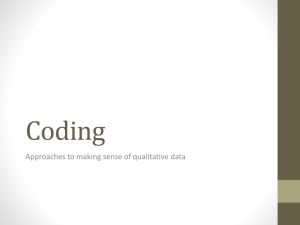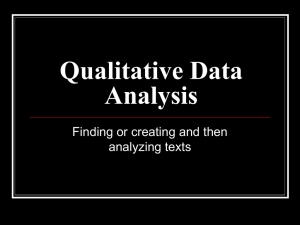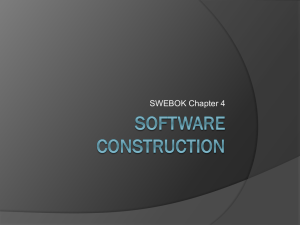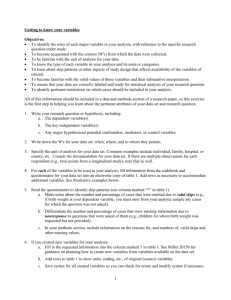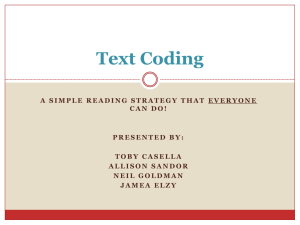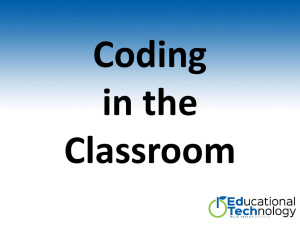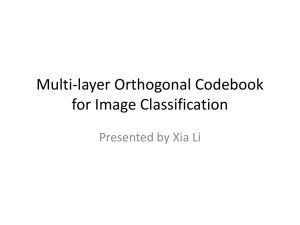Research Methodology - Akademik Ciamik 2010
advertisement
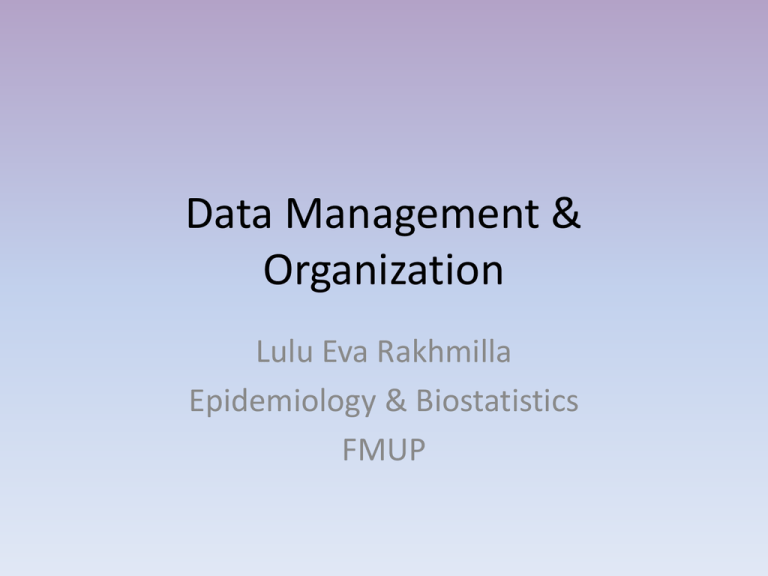
Data Management & Organization Lulu Eva Rakhmilla Epidemiology & Biostatistics FMUP Research process- Steps 1. Formulation a of a research problem 2. Creation of a research design 3. Constructing instruments for data collection 4. Selecting a sample 5.Writing the research proposal 6. Collecting data 7. Processing data 8. Writing the report Collection data Data collection Why? What? How? Who? Where? When? Ethics Data storage, entry and management Databases Checking Data presentation Answer your research question How not to present your results… Collection data • Without data, there would be no results! • Without results, you have little to publish or present. • Without publications or presentations, you cannot establish yourself as a researcher. Collection data 1st Qs = What is my research question? What do I need to know to answer this Qs? Planning : Qualitative study ? Quantitative study ? Collection data • Ethical issues relating to research participants ( their consent, incentives, sensitive information, harm to participants etc.) • Ethical issues relating to the researcher (avoiding bias, using appropriate research methodology, correct reporting etc.) Data vs. information: What is the difference? What is data? – Data can be defined in many ways. Information science defines data as unprocessed information. What is information? – Information is data that have been organized and communicated in a coherent and meaningful manner. Data is converted into information, and information is converted into knowledge. Knowledge; information evaluated and organized so that it can be used purposefully Processing data • • • • • Editing data Coding data Verifying coded data Analyzing data Displaying data (charts, diagrams, tables) Steps in data processing Coding Row Data Interviews Questionaires Interview Guide Secondary source Developing a code book Developing a frame of analysis Pre-testing the code book Analysis by computer or manual Coding the data Editing Analysis Verifying the coded data Editing data PROBLEMS Forget to ask a Qs Forget to record a response Wrongly classify a response Write only half a response Write illegibly SOLUTION • Checking the contents for completeness • Checking the responses for internal consistency Editing data • Simply ways minimising the problems By inference By recall By going back to respondent • Assess internal consistency Examine answers to one question or variables at a time Examine all Qs at the same time, that is examine responses given by a respondent Coding data Having a ‘clean’ data • A systematic way in which to condense extensive data sets into smaller analyzable units through the creation of categories and concepts derived from the data. • The process by which verbal data are converted into variables and categories of variables using numbers, so that the data can be entered into computers for analysis. Coding data Purposes • The way a variable has been measured (measurement scale) in your research instrument • The way you want to communicate the findings about a variable to your readers Coding data Do you like ice cream? When to code • When testing a hypothesis (deductive), categories and codes can be developed before data is collected. • When generating a theory (inductive), categories and codes are generated after examining the collected data. – Content analysis – How will the data be used? Codebook Codebook Codebook Levels of Coding (For qualitative data) • Open – Break down, compare, and categorize data • Axial – Make connections between categories after open coding • Selective – Select the core category, relate it to other categories and confirm and explain those relationships Codebook Codebook Data Screening • Used to identify miscoded, missing, or messy data • Find possible outliers, non-normal distributions, other anomalies in the data • Can improve performance of statistical methods • Screening should be done with particular analysis methods in mind Determining Codes (Bourque, 2004) • For surveys or questionnaires, codes are finalized as the questionnaire is completed • For interviews, focus groups, observations, etc. , codes are developed inductively after data collection and during data analysis Importance of codebook (Shenton, 2004) • Allows study to be repeated and validated. • Makes methods transparent by recording analytical thinking used to devise codes. • Allows comparison with other studies. Determining Codes, cont. • Exhaustive – a unique code number has been created for each category • Mutually Exclusive – information being coded can only be assigned to one category • Residual other – allows for the participant to provide information that was not anticipated, i.e. “Other” _______________ Determining Codes, cont. • Missing Data - includes conditions such as “refused,” “not applicable,” “missing,” “don’t know” • Heaping – is the condition when too much data falls into same category, ex. college undergraduates in 18-21 range (variable becomes useless because it has no variance) Creating Code Frame Prior to Data Collection (Bourque, 2004; Epstein & Martin, 2005) • Use this when know number of variables and range of probable data in advance of data collection, e.g. when using a survey or questionnaire • Use more variables rather than fewer • Do a pre-test of questions to help limit “other” responses Transcript (Shenton, 2004) • • • Appropriate for open-ended answers as in focus groups, observation, individual interviews, etc. Strengthens “audit trail” since reviewers can see actual data Use identifiers that anonymize participant but still reveal information to researcher ex. Y10/B-3/II/83 or “Mary” Three Parts to Transcript (Shenton, 2004) 1. Background information, ex. time, date, organizations involved, participants. 2. Verbatim transcription (if possible, participants should verify for accuracy) 3. Observations made by researcher after session, ex. diagram showing seating, intonation of speakers, description of room Postcoding (Shenton, 2004) 1. Post-meeting observations 2. Post-transcript review a. Compilation of insightful quotations b. Preliminary theme tracking c. Identification of links to previous work 3. Create categories and definitions of codes Coding Mixed Methods • When compared to quantitative research, qualitative research is perceived as being less rigorous, primarily because it may not include statistics and all the mumbo jumbo that goes with extensive statistical analysis. Qualitative and quantitative research methods in librarianship and information science are not simply different ways of doing the same thing. Coding Mixed Methods Advantages and Disadvantages Advantages • Improves validity of findings • More in-depth data • Increases your capacity to cross-check one data set against another • Provides detail of individual experiences behind the statistics • More focused questionnaire • Further in-depth interviews can be used to tease out problems and seek solutions • • • • • Disadvantages Inequality in data sets “Data sets must be properly designed, collected, and analyzed” “Numerical data set treated less theoretically, mere proving of hypothesis” Presenting both data sets can overwhelm the reader Synthesized findings might be “dumbed-down” to make results more readable Key Point in Coding Mixed Methods Data • The issue to be most concerned about in mixed methods is ensuring that your qualitative data have not been poorly designed, badly collected, and shallowly analyzed Examining a Mixed Methods Research Study • Makani, S. & Wooshue, K. (2006). Information seeking behaviors of business students and the development of academic digital libraries. Evidence Based Library and Information Practice, 1(4), 30-45. Study Details Population Purposive population, 10 undergraduates (2 groups) / 5 graduate students Undergraduate business students at Dalhousie University in Canada Objectives Methods To explore the information-seeking behaviors of business students at Dalhousie University in Canada to determine if these behaviors should direct the design and development of digital academic libraries. Data: Used both quantitative and qualitative data collected through a survey, in-depth semistructured interviews, observation, and document analysis. Qualitative case study data was coded using QSR N6 qualitative data analysis software. Study Observations • Followed 3 groups of business students working on group project assignments. The assignments involved formulating a topic, searching for information and writing and submitting a group project report. Coding Methods • Used pre-selected codes from literature review: – Time – Efficiency of use – Cost – Actors – Objects (research sources) Coding: Ordinal Measures • Opinion Survey What sources do you use to get started on your research? Examples of Ratio-Interval Coding and Level of Measurement • The age of the survey participants (survey and group study) ranged from 18 – 45 years. • Most of the undergraduates were between 18 and 25 years of age (95%) • While 56% of graduate students fell within the same age range. Study Conclusions • This study reveals that in order to create an effective business digital library, an understanding of how the targeted users do their work, how they use information, and how they create knowledge is essential factors in creating a digital library for business students. Study Weaknesses: Use of Mixed Methods Data • No discussion of how the survey was delivered electronically • Survey questions were not included in the published article • Created for a long results section Study Advantages: Use of Mixed Methods Data • Numeric data helped create a clearer picture of the participants • Numeric data from the survey questions nicely compliments the excerpts from the semi-structured interviews Lets Practice 1. Please indicate, your current age in completed years:_______ 2. Please tick, your marital status: – Currently married _____ – Living in a de facto relationship _____ – Separated _____ – Divorced _____ – Never married _____ Continued 3. If Tertiary/University, please specify the level achived and area of study. (Please specify all postgraduate qualifications). Level of achievement Area of study Associate Diploma Diploma Bachelor Graduate Diploma Masters PhD 4. What, in your opinion, are the main differences between your jobs prior to and after redeployment? Continued 5. We would like to know your perception of the two jobs before and after redeployment with respect to the following aspect of your job. Please rate them of a five point a scale, using the following guide. 5= extremely satisfied Before redeployment 1 2 3 4 5 4= very satisfied 3= satisfied Areas Job status Job satisfaction Motivation to work Interest in the job Self esteem Professional competence Peer interaction Morale Work environment Social interaction 2= dissatisfied 1= extremely dissatisfied After redeployment 1 2 3 4 5 References 1. Bourque, Linda B. "Coding." In The Sage Encyclopedia of Social Science Research Methods. Eds. Michael S. Lewis-Beck, Alan Bryman, and Timothy Futing Liao, v. 1, 132-136. Thousand Oaks, Calif.: Sage, 2004. 2. Lee, Epstein and Andrew Martin. "Coding Variables." In The Encyclopedia of Social Measurement. Ed. Kimberly Kempf-Leonard, v.1, 321-327. New York: Elsevier Academic Press, 2005. 3. Shenton, Andrew K. “The analysis of qualitative data in LIS research projects: A possible approach.” Education for Information 22 (2004): 143-162. 4. Kumar, Ranjit (2000). Research methodology : a step by step guide for beginners, 3rd. ed., Sage, London



